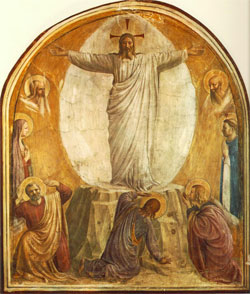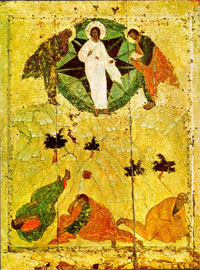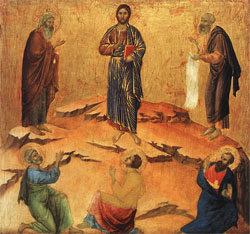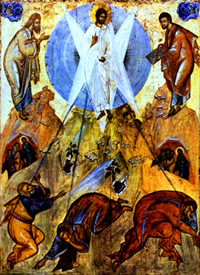The Transfiguration of Jesus:
"The Real Truth" or A "Pernicious Superstition?"
For Sunday February 3, 2008
Lectionary Readings (Revised Common Lectionary, Year A)
Exodus 24:12–18
Psalm 2 or 99
2 Peter 1:16–21
Matthew 17:1–9
 |
Transfiguration, Fra Angelico, Italy (1400–1455). |
The story of the "transfiguration" of Jesus (Greek, metamorphosis) is so central to the gospel that all three synoptic writers include it (Matthew 17:1–8 = Mark 9:2–10 = Luke 9:28–36). It's also a story that begs some important questions. What are we reading here? A fable, a myth, or some theological metaphor? Eyewitness history? Or maybe some combination of these genres?
In Mark's version we read:
After six days Jesus took Peter, James, and John with him and led them up a high mountain, where they were all alone. There he was transfigured before them. His clothes became dazzling white, whiter than anyone in the world could bleach them. And there appeared before them Elijah and Moses, who were talking with Jesus. Peter said to Jesus, "Rabbi, it is good for us to be here. Let us put up three shelters—one for you, one for Moses and one for Elijah." (He did not know what to say they were so frightened). Then a cloud appeared and enveloped them, and a voice came from the cloud: "This is my Son, whom I love, listen to him!" Suddenly, when they looked around, they no longer saw anyone with them except Jesus. As they were coming down the mountain, Jesus gave them orders not to tell anyone what they had seen until the Son of Man had risen from the dead. They kept the matter to themselves, discussing what "rising from the dead" meant.
Some readers dismiss this story as a bizarre fiction. The diatribes by atheist writers come to mind — Sam Harris, Richard Dawkins, Daniel Dennett, Christopher Hitchens, and now John Allen Paulos's new book called Irreligion: A Mathematician Explains Why the Arguments for God Just Don’t Add Up.
 |
Transfiguration, Andrei Rublev, Russia (1405). |
This "noisy boomlet of antireligion books," as Michiko Kakutani calls them (NYT, January 22, 2008), is a modern version of ancient disdain. In his Life of Nero, Suetonius (75–160) derided Christians as "a set of men adhering to a novel and mischievous superstition." In his Annals, Tacitus (c. 60–120) sneered at the "pernicious superstitions" of believers. For Pliny the Younger (62–113), governor of Pontus-Bithynia (in modern Turkey) from 111–113, the many Christians under his rule posed a practical problem. In two famous letters to the emperor Trajan he expressed frustration about how to prosecute believers: "I judged it so much the more necessary to extract the real truth, with the assistance of torture, from two female slaves, who were styled deaconesses, but I could discover nothing more than depraved and excessive superstition."
A different reading tries to have its cake and eat it, too. It purges the story of offensive elements while retaining some kernel of truth — for example, interpreting the transfiguration as an embellished tale, as a truth communicated by myth or metaphor, or even as a misplaced and reinterpreted account of the resurrection. But this strategy is easier said than done. Its tendency, as history has shown, has been to make the ancient story look and sound suspiciously like the modern critic.
CS Lewis observed that it's a healthy exercise to own up to those elements in original Christianity that you find obscure or repulsive. When we do this, he says, we're less likely to "skip, or slur, or ignore what we find disagreeable." Similarly, I like the advice of Harvey Cox, who cautions against encountering the "sweeping vision" of Christian eschatology, only to "whittle it down to something manageable and lackluster" (When Jesus Came to Harvard).
Decades after the transfiguration Peter appealed to their terrifying experience precisely to rebut criticisms that the early believers followed "cleverly invented stories" as opposed to "eyewitness" accounts of actual events (2 Peter 1:16–18). The details of the story — exactly six days after Peter's confession that Jesus is the Christ (Mark 8:27–30), the identification of Mount Hermon in present-day Syria which reaches 9,000 feet, the secluded and private nature of the incident, the palpable fear they exhibited, Peter's impulsive outburst, and their confusion about something so essential as the resurrection from the dead — all these unflattering details suggest that the evangelists were writing history and not myth or metaphor, even if the story, like so many stories in the Gospels, is easier to describe than to explain.
 |
Transfiguration: Duccio di Buoninsegna, Italy (1308–1311). |
It's true that people of their time and place enjoyed a world view that's different from ours, but this doesn't mean that Christians back then were inherently more credulous than we are today. I find it hard to fathom why the evangelists would propagate a story that they knew was false, and knew that their detractors could falsify, knowing that a needlessly ludicrous claim would harm their cause, and knowing, as they surely did for the first 250 years of the church, that making outrageous claims would earn them social ridicule, political marginalization, and physical persecution. Peter and the disciples would have been wrong to deny an experience that they had, no matter how bizarre or difficult it was to comprehend and explain.
Whether Peter, James and John had an ecstatic vision, or whether Jesus was literally if briefly "metamorphosed" before their very eyes, the natural, physical phenomenon of brilliant light was secondary to the supernatural, metaphysical affirmation of the voice from the cloud — this Jesus whom the disciples followed was not just an itinerant rabbi, a clever sage, a socio-political provocateur, a subversive wisdom teacher, an ascetic, or a failed apocalyptic troublemaker. The transfiguration portrays Jesus as the Cosmic Lord of all human history. He is God's beloved and specially anointed Son. The ramifications of this are obvious: "Listen to him!" (Matthew 17:5).
Three marvels accompanied the transfiguration. First, Jesus's clothes radiated blinding light. Matthew compares this radiance to the brilliance of the sun (Matthew 17:2), Mark to super-bleached laundry (Mark 9:3), and Luke to "a flash of lightning" (Luke 9:29). These descriptions evoke comparisons to Moses on Mount Sinai when Yahweh appeared to him in a cloud and consuming fire (Exodus 24). Paul described his famous conversion on the road to Damascus as an encounter with blinding light accompanied by a voice from heaven (Acts 22:6, 26:13), which testimony lends an experiential aspect to his declaration that God "dwells in unapproachable light" (1 Timothy 6:16).
Second, Moses and Elijah appeared. In his transcendent glory Jesus fulfills the law that Moses received, and consummates the end of all things that Elijah was thought to harbinger. He's the New Moses, a Greater than Elijah, if you will. Third, the voice of God the Father from a cloud, reminiscent of that at his baptism, affirms what Peter had confessed just one page earlier in the gospel, that Jesus is God's beloved and specially appointed Son who merits our total allegiance: "Listen to him!"
 |
Theophanes the Greek, late 14th century. |
It's easy for Christians who have become over-familiar with the gospel texts and traditions to domesticate and diminish them — to tame the ineffable, trivialize the indescribable, to cut and trim God down to our size so that we can manage Him. In his book What Jesus Meant, Garry Wills recaptures the radically subversive life, teaching, death, and resurrection of Jesus of Nazareth: "He intended to reveal the Father to us, and to show that he is the only-begotten Son of that Father. What he signified is always more challenging than we expect, more outrageous, more egregious." He excoriates Thomas Jefferson's scissored-down Jesus who is little more than a "mild humanitarian moralizer," and the more recent Jesus Seminar scholars ("the new fundamentalism") who end up with a bland cardboard cutout.
The transfiguration of Jesus belies all the ways we dilute the stringent wine of the Gospel. The blinding light and the voice from the clouds challenge faith that has turned tepid, perfunctory, and bored. In her book Teaching a Stone to Talk, Annie Dillard thus asks:
Does anyone have the foggiest idea of what sort of power we so blithely invoke? Or, as I suspect, does no one believe a word of it? The churches are children playing on the floor with their chemistry sets, mixing up a batch of TNT to kill a Sunday morning. It is madness to wear ladies' straw hats and velvet hats to church; we should all be wearing crash helmets! Ushers should issue life preservers and signal flares; they should lash us to our pews! For the sleeping God may awake someday and take offense, or the waking God may draw us to where we can never return.
I can understand how some people read the transfiguration story and, as Dillard admits, "not believe a word of it." But I pray that God will save me from the safe middle ground of self-serving, domesticating deism.
For further reflection:
* How do we "whittle down" (Cox) accounts like the transfiguration? Why?
* Consider the many ways we trivialize the Gospel and "domesticate" God.
* What are the parallels between Moses, Elijah, and Jesus, between Exodus 24 and the account of the transfiguration?
* Why do you think Jesus gave Peter, James and John orders not to tell anyone what they had seen until he had risen from the dead?
* For further study, see Donald McCullough, The Trivialization of God; The Dangerous Illusion of a Manageable Deity (1995).
Image credits: (1) Web Gallery of Art; (2) Rollins College, (3) Carol Gerten-Jackson; (4) Auburn University, Russian resources





